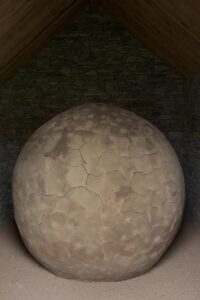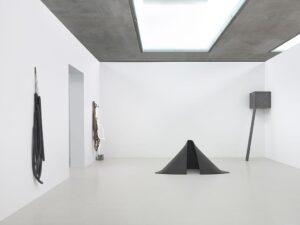
Intensely anticipated by the New York and DC art community, October 4 marked the public opening of the Mitch and Emily Rales’ Foundation’s “Pavilions”. Billing itself as the latest U.S. non-profit museum, it may not qualify as a museum at all. According to the International Council of Museums, a worldwide body of museum professionals a museum is “a non-profit permanent institution in the service of society and its development open to the public, which acquires, conserves, researches, communicates and exhibits…for the purpose of education and enjoyment.”
Glenstone’s two non-profit ventures satisfy none of these requirements. It might not satisfy its non-profit status either. In 2008, Senator Orrin Hatch’s Senate Finance Committee stipulated that institutions enjoy non-profit status in return for the owners giving up the power of ownership. That is hardly the case with the Glenstone Foundation or The Pavilions. Emily Rales, Director and Curator of the Pavilions collection, solely chooses which artists’ work to include and display and refuses to engage in serious research or education.
Mrs. Rales requires an artist to have shown at a museum or major gallery for fifteen years before consideration for the collection. Galleries and museums nurture talent by buying work and supporting the artist from the inception of a career, enabling new work. Over fifteen years, the best and seminal work has largely been spoken for, leaving lesser work not desired by galleries, collectors or museums to become available. The Rales make a point of not attending international art fairs such as Art Basel, where better work might be available due to owners selling it to galleries. They prefer to buy directly from the artist, establishing a personal connection, but also buying only what is left or newly created expressly for them.
What is really happening is that the Rales Foundation continues to amass a collection of ‘names’. The quality of the work does not matter, as long as the famous artist, already known to the public, is represented. The quality of every artist’s work I saw at the Pavilions and at the Glenstone Foundation, predecessor to The Pavilions, called a starter museum by Mitch Rales at the press opening for the Pavilions, was lacking in contrast to work in museums and private collections. There is no depth to the collection and no daring. It is a safe collection, made up of proven names in the art world, represented by work of lesser quality. A suburban institution, it attracts a public who can say they saw a Warhol or a a Koons or a Bourgeois sculpture, name-dropping as is unfortunately the practice of the public in contemporary times and in wealthy suburban enclaves. The lack of research and education does not matter, as this public is not interested to learn more about an artist’s career but would rather enjoy a day in the country quietly walking amongst works by artists from the contemporary canon whose names are instantly recognizable. The opening of The Pavilions underscored their inspiration and aspiration, as the attendees mirrored those often encountered at New York or London openings, where fashionably-clad, white wine sipping patrons assess each others’ appearance rather than the art’s.

In the foundation building, the “Starter” museum, the current Louise Bourgeois show provided a comprehensive look at all aspects of her long career, but the quality at all points was not there, because the work was held by major collections and museums. The preceding show, of Roni Horn’s photographs of the Thames and sculptures of solid glass, mimicking that photographic lens, are out of place here. Without the context of the Thames, outside the Tate, as part of the nominated work for the Turner Prize, they do not make sense, becoming pretty photographs of some unknown water source. Nor do the sculptures, pink glass upturned to resemble a photographic lens, seemingly capable of photographing the visage of the viewer staring down into it. There is no aesthetic position taken, no context provided. Fred Sandback’s lyrical optical tricks of colored yarn comprised the biggest solo success of the three most recent exhibitions at the “Starter”. Not yet popular, and therefore featuring his best work to date, his minimal “structures”, delineated spaces bordered with yarn, work. The air they encompass exists only due to the tautness of the yarn outline, allowing the forms to breathe, while still standing against the white walls. Seeming no less existential than Dan Flavin’s geometric forms of light, they function as outlines of spaces, and do not seem lost in the Starter’s vast, white space.

At the new Pavilions, the Rales aim to provide a quiet contemplative, slow experience where people might contemplate the art. Slow is the new buzzword. Quiet and contemplation is a polite alternative to our present reactive culture. When one is quiet, conversation or debate is absent. The guides constant query, “How does this sculpture make you feel?” adds to the feel good yoga-like vibe encouraged by Glenstone. Miles from any urban center, isolated due to its purchase of many surrounding houses added to Glenstone’s fiefdom, totally controlled in every aspect by the Lord and Lady of the Manor, the Rales, this feudal kingdom displays its collection in a building comparable to a prison, where, doing time, all I wanted was to escape to the reality of noise and debate and art that is not safe, that takes a chance, that explores and dares.
In the northern reaches of Potomac, Maryland, guards checked my credentials before I was allowed to drive to the parking lot. A red crushed stone walking path connected the parking lot to the Pavilions. Once there, I entered a cedar-walled arrivals hall leading down a stair, lined on both sides with unadorned walls of some of the 26,000 grey concrete blocks required to build The Pavilions. Downstairs rooms led into each other with identifying labels on side walls naming the work occupying the space. There is good work here, although regrettably, work by the best artists here is not represented more deeply. Among the best is Pipilotti’s List’s 1976 video, “Ever is Over All” which I saw exhibited in the Hirshhorn Museum’s show “Regarding Beauty: A View of the Late Twentieth Century”. In the video, a figure later revealed to be a woman smashes car windows with a baseball bat. Martin Puryear, just chosen to be the U.S. representative at the 2019 Venice Biennale, is here represented by “Big Phrygian”, a huge reproduction and sole sculpture in a room, of a Phrygian cap, worn by liberals during the French Revolution. A symbol of liberation, as is Rist’s smashing of car windows, corroborates my impression of The Pavilions as somewhere from which to escape or liberate oneself. Standing under cold light, from skylights covered in plastic, and clerestory windows admitting little light, in the concrete-block surrounded space, it stands overseen by a museum guide dressed in a grey smock keeping watch over the viewers, querying the public about their reactions to the art, begging the question of whether this more resembles a prison or a mental institution.
Roni Horn’s two solid-glass drum like sculptures, rescued from a past show at the Starter museum, with glass resembling a photographic lens turned upwards encourages the viewer to look down into that “lens”, corroborating their coding as instruments of surveillance, further adding to the prison-like aesthetic.

Robert Gober’s installation takes up an entire room, with a wall mural of a forest, featuring protruding bars and sinks with running water, with piles of newspapers on the floor. Although this might refer to forest deforestation, the sinks, and newspapers, (recalling what crime?) again recall a prison room.
Outside, Michael Helzer, a land-artist, has worked with Emily Rales for several years to create ‘Collapse’. Multiple wooden beams are arranged helter-skelter in an open pit, surrounded by crushed stone, as museum guides admonish viewers to stay far from the edge lest they fall in. The surrounding walls, more than eight feet high, are constructed of the same grey concrete block as The Pavilions. As there are no holes in the walls, there is no way these beams could have fallen into the pit at the angle they are arranged. So all the viewer is aware of is the danger of falling into the pit, and wondering what happened. Is this not the same question one asks in a dungeon, or when observing a disaster that cannot be explained?
Michael Helzer’s ‘Collapse’ best signifies the philosophy of the collection. It is safe art. This safe collection purports to bring one to the edge – but the Rales are afraid to jump in, and keep me from doing so. Asking perfunctory questions, making a show of engaging the viewer, guides want to know how I feel about the work. I want to know how those beams got there; why Emily Rales chose Andy Warhol’s Flowers and Rauchenberg’s Untitled (Early Egyptian).
Without a comprehensive well-thought out collection, my questions cannot be answered. Anyway, I know the answer: these works by name artists was available.
Additional work shown in rooms shared by artwork at the Pavilions include name artists Andy Warhol’s painting, Large Flowers (1964), the instantly recognizable print which adorns college dorm rooms and first apartments nationwide; Jackson Pollack’s Number 1, his 1952 drip painting of rather drab coloration, Rothko’s Number Nine (White and Black on Wine) from Rothko’s depressive phase, lacking the startling color vibrations of earlier work, one of seven of Duchamp’s Fountain (1917/1964), that iconic urinal that questioned the meaning of art and led to manifestoes galore, Barbara Kruger’s Untitled (We won’t pay nature to your Culture), a Jasper Johns orange flag, and other work of famous and iconic artists. Fairly bored with all I had seen before, better contextualized and shown to better advantage, that slow movement Glenstone hopes to induce became a cursory look at readily recognizable work, and a rapid walk through the prison-like maze of increasingly claustrophobia-inducing grey concrete block walled galleries was the obvious result.

Exiting the Pavilions, up the stairs, rounding the corner, I escaped, encountering true nature, albeit controlled, where the galleries of the Pavilions surround a central aquatic courtyard, open to the sky. Control returns as aquatic plants in the outside tubs are replaced when they reach beyond a uniform height. But maybe this is what Glenstone does best; making the comparison between natural landscape and man-made, with the natural winning; making the galleries inside so unappealing that one seeks to immerse oneself in the natural, light-filled, outside world.
Surrounding Glenstone’s buildings, installations by famous artists interrupt the landscape, presenting the best at Glenstone, Necessitating walking down a muddy path, Andy Goldsworthy’s Clay Houses (Boulder-Room Holes), a sequence of three clay houses one can enter, smelling and observing the beauty of earthen clay and imagining the feudal era tenants lucky enough to live in an earthen hut rather than the dungeon-like main house; Richard Serra’s Contour, providing a strong steel barrier holding back natural grass-covered earth, a weapon-like material segregating one part of the estate from the other; Michael Helzer’s Compression Line, which from afar might be a river under a border wall, but is actually a gash in the earth beyond that barbican, or Jeff Koons’ Split Rocker, a giant dog’s head covered with newly planted foliage each season, again showing control of nature.
We are constantly reminded of Glenstone’s total control of the environment, within The Pavilions or in the landscape where molded walls hold back grasses and wildflowers, determining one’s path. Quiet ensues. But rather than bringing about contemplation, one tries not to trip on the gravel or slide in the mud, urging one to escape and rush to that wilderness of native grasses that surrounds it, risking inevitable scratches. Out in the wild, avoiding the paths, on the hill leading to Split Rocker overseeing the wildflower covered hill, a silent watchdog looked down on me, freely enjoying the nature and art that the Rales have not yet corralled.
Nancy Schreiber
Volume 33 no 2 November / December 2018 pp 10-14
